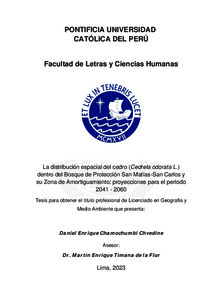| dc.contributor.advisor | Timana de la Flor, Martin Enrique | |
| dc.contributor.author | Chamochumbi Chvedine, Daniel Enrique | |
| dc.date.accessioned | 2023-07-14T21:16:20Z | |
| dc.date.available | 2023-07-14T21:16:20Z | |
| dc.date.created | 2023 | |
| dc.date.issued | 2023-07-14 | |
| dc.identifier.uri | http://hdl.handle.net/20.500.12404/25373 | |
| dc.description.abstract | La Amazonía peruana representa el 60.9% del territorio nacional (Infobosques,
2009). Es debido a su gran extensión y complicada accesibilidad por lo que en ella
se generan procesos complejos que se amplifican debido a una débil presencia
del Estado y gestión ineficaz de los recursos naturales. Las Áreas Naturales
Protegidas buscan salvaguardar la naturaleza y los servicios ecosistémicos que
esta nos brinda. Sin embargo, en algunas de ellas, como es el caso del Bosque de
Protección San Matías-San Carlos, la gestión efectiva se complica por factores
antrópicos que ocasionan perturbaciones en los ecosistemas, los cuales pueden
verse potenciados a futuro bajo un contexto de cambio climático y, en
consecuencia, afectar a especies de gran valor como la especie forestal Cedrela
odorata L. (cedro). No obstante, la brecha de información es una de las limitantes
principales para una adecuada toma de decisiones, por lo que es necesario
determinar aspectos como la distribución espacial del cedro en el ANP, realizar
proyecciones a futuro considerando diversos escenarios de cambio climático y,
además, delimitar las zonas específicas de mayor presión antrópica para generar
acciones efectivas basadas en ciencia que contribuyan a una mejor gestión del
territorio. Para ello, se empleó el software de Modelamiento de Distribución de
Especies Maxent 3.4.4., en el cual se empleó 99 puntos de ocurrencia del cedro y
21 variables de predictores ambientales, tanto para la actualidad como para el
periodo 2041 – 2060 bajo los escenarios de cambio climático RCP 4.5 y 8.5.
Asimismo, se identificó las áreas de mayor presión de deforestación mediante un
mapa de densidad de Kernel para priorizar zonas en donde es necesario
fortalecer el control. Finalmente, el análisis determinó que podría existir una
alarmante reducción del 81.5% y 91% del área de mayor probabilidad de
distribución del cedro para los escenarios futuros de cambio climático intermedio
(RCP 4.5) y pesimista (RCP 8.5), respectivamente. | es_ES |
| dc.description.abstract | The Peruvian Amazon represents 60.9% of the national territory (Info Bosques,
2009). Due to its great extension and difficult accessibility complex processes are
generated in it, which are amplified due to a weak presence of authorities and
the inefficient management of natural resources. Protected Natural Areas
objective is to safeguard nature and the ecosystem services it provides. However,
in some of them, such as the Bosque de Protección San Matías-San Carlos,
effective management is threatened by anthropic factors that cause disturbances
in the ecosystems, which may be enhanced in the future in a climate change frame
and, as a consequence, affect species of great value such as Cedrela odorata L.
(cedar). However, the information gap is one of the main limitations for decision
making, so it is necessary to stablish the current spatial distribution of cedar in
the protected area, make future projections considering some climate change
scenarios, and, in addition, determine the specific areas of greatest anthropic
pressure, in order to generate effective actions based on science that contribute
to improve management of the territory. For this, the Maxent 3.4.4 Species
Distribution Modeling software was applied, in which 99 points of occurrence of
cedro and 21 variables of environmental predictors were introduced, both for the
present and for the period 2041 - 2060 under the RCP 4.5 and 8.5 climate change
scenarios; likewise, the areas of greatest deforestation pressure were identified
through a Kernel density map to prioritize areas where it is necessary to
strengthen control. Finally, the analysis shows that there would be an alarming
reduction of 81.5% and 91% in the area of greatest probability of distribution of
cedro for future intermediate (RCP 4.5) and pessimistic (RCP 8.5) climate change
scenarios, respectively. | es_ES |
| dc.language.iso | spa | es_ES |
| dc.publisher | Pontificia Universidad Católica del Perú | es_ES |
| dc.rights | info:eu-repo/semantics/openAccess | es_ES |
| dc.rights.uri | http://creativecommons.org/licenses/by/2.5/pe/ | * |
| dc.subject | Áreas naturales--Perú--Amazonía, Región | es_ES |
| dc.subject | Deforestación--Perú--Amazonía, Región | es_ES |
| dc.subject | Cambio climático--Perú--Amazonía, Región | es_ES |
| dc.subject | Bosques--Conservación--Perú--Amazonía, Región | es_ES |
| dc.title | La distribución espacial del cedro (Cedrela odorata L.) dentro del Bosque de Protección San Matías-San Carlos y su Zona de Amortiguamiento: proyecciones para el periodo 2041 - 2060 | es_ES |
| dc.type | info:eu-repo/semantics/bachelorThesis | es_ES |
| thesis.degree.name | Licenciado en Geografía y Medio Ambiente | es_ES |
| thesis.degree.level | Título Profesional | es_ES |
| thesis.degree.grantor | Pontificia Universidad Católica del Perú. Facultad de Letras y Ciencias Humanas | es_ES |
| thesis.degree.discipline | Geografía y Medio Ambiente | es_ES |
| renati.advisor.dni | 25696637 | |
| renati.advisor.orcid | https://orcid.org/0000-0003-1559-4449 | es_ES |
| renati.author.dni | 72804687 | |
| renati.discipline | 532036 | es_ES |
| renati.juror | Bohl Pazos, Ricardo Enrique | es_ES |
| renati.juror | Timaná De La Flor, Martín Enrique | es_ES |
| renati.juror | Cuentas Romero, María Alejandra | es_ES |
| renati.level | https://purl.org/pe-repo/renati/level#tituloProfesional | es_ES |
| renati.type | https://purl.org/pe-repo/renati/type#tesis | es_ES |
| dc.publisher.country | PE | es_ES |
| dc.subject.ocde | https://purl.org/pe-repo/ocde/ford#1.05.08 | es_ES |







